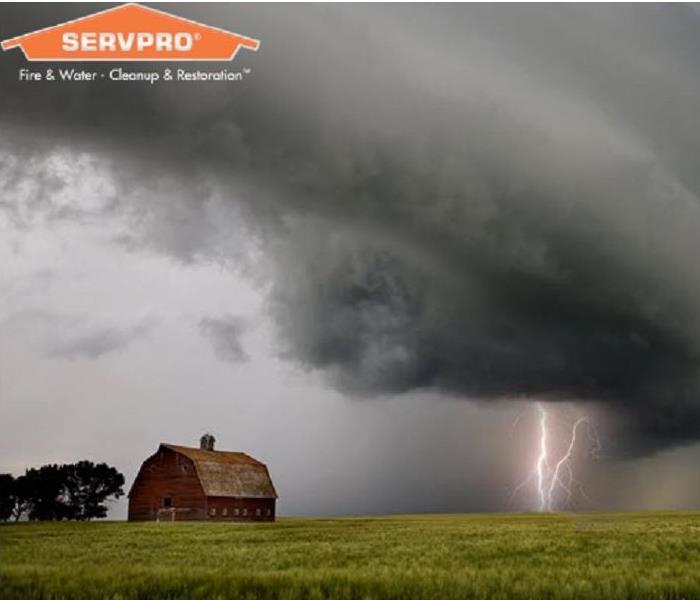Archived Storm Damage Blog Posts
How SERVPRO Can Be Your Lifeline in Spring Emergencies
3/26/2024 (Permalink)
As spring arrives, so does the unpredictable nature of the weather. The beauty of blooming flowers and warmer temperatures also brings the potential for severe storms, including heavy rains, high winds, and even tornadoes. While we embrace the season's renewal, preparing for the unexpected is essential.
Spring storms can wreak havoc on homes and businesses, causing water damage, structural issues, and other challenges. In times of crisis, having a reliable partner to turn to can make all the difference. That's where SERVPRO comes in.
Immediate Response
When disaster strikes, every minute counts. SERVPRO understands the urgency of spring storm emergencies and is available 24/7 to respond promptly to your call for help. Our trained technicians arrive on the scene with the necessary tools and expertise to assess the damage and begin the restoration process immediately.
Expert Restoration Services
SERVPRO specializes in a wide range of emergency restoration services tailored to address the unique challenges of spring storms. From water extraction and drying to mold remediation and debris cleanup, our team is well-equipped to handle any situation professionally and carefully. We work tirelessly to restore your property to its pre-storm condition, providing peace of mind during a stressful time.
Compassionate Support
Dealing with the aftermath of a spring storm can be overwhelming, but you don't have to go through it alone. SERVPRO not only offers expert restoration services but also provides compassionate support and guidance throughout the process. We understand the emotional toll that emergencies can take, and we're here to support you every step of the way.
Preparedness for the Future
While we can't prevent spring storms from occurring, we can help you prepare for future emergencies. We suggest entering your local SERVPRO franchise's phone number in your phone as an emergency contact. Calling us as soon as disaster strikes can help protect your home or business by immediately mitigating the damage.
SERVPRO is your trusted partner in times of crisis, providing immediate response, expert restoration services, and compassionate support when you need it most. Together, we can weather any storm that comes our way.
Stay Off Flooded Roads
4/12/2022 (Permalink)
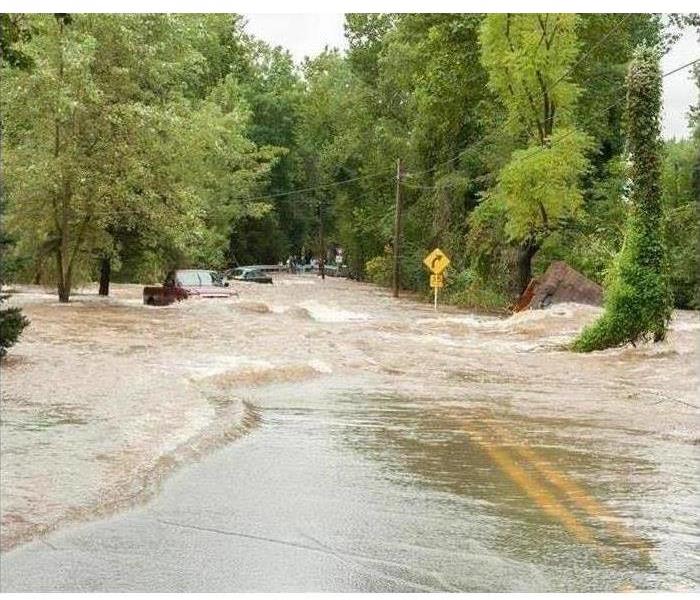 Flooding in the street.
Flooding in the street.
It can be frustrating to be stuck inside your house when it’s flooding, but it is important that you avoid driving in this situation. A flooded street may seem easy to handle, but it can be a risk to your safety. The following are just a few reasons why it is best to stay off the roads during a severe storm.
One reason to avoid flooded roads is that it can cause serious damage to your vehicle. Your car is not made to be driven in water, so it does not have the necessary equipment to protect it. If water enters your engine, it can cause it to stop functioning correctly and leave you with massive repair bills. Areas of your car may rust, and electronic components can be ruined.
Even if you think the road looks safe, there might be something lurking beneath the water’s surface. A flooded street may be hiding potholes, tree branches and debris from the storm. Any of these could damage your car and make it more difficult for you to drive safely.
Whether you have been driving for a few years or a few decades, you cannot be prepared for everything. Even a long history of driving experience is not enough to keep you safe during a flood. Moving water in a flooded street can easily sweep your car away and create an incredibly dangerous situation. Just a few inches of water can cause you to hydroplane and result in a crash.
One of the best travel tips for driving during a flood is simply not to do it. Stay put if possible and, once the water has receded, you can find a more comfortable place to stay while an emergency restoration company performs any necessary repairs on your damaged home.
Call SERVPRO of Farmington 573-756-5191.
Trees and Tornadoes
8/20/2021 (Permalink)
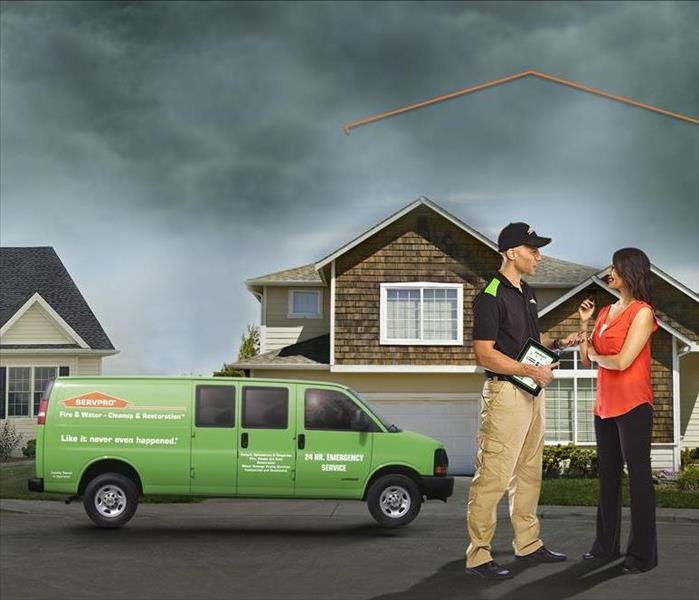 Storm damage? We can help you.
Storm damage? We can help you.
Tree Branches Become Debris in a Tornado
We love to have our tall leafy trees in our yards to keep our house cool during the summer heat. The shade they provide is wonderful when the sun is high in the sky.
These same trees we love can also be very harmful during a storm or tornado if they are not trimmed regularly. Strengthening the trees around your property can help keep their limbs from being torn off and becoming debris in a storm. Here is what to look for when trimming trees around your home:
- Limbs with wounds
- Decaying branches
- Structural defects
- Limbs rubbing against each other
- Exposed roots
If your trees are trimmed properly before the stormy season they will be less likely to become debris. Many homes can be destroyed by tornadoes in our servicing area if a tornado would arise. Learn more about the ways SERVPRO of Farmington can help during stormy weather. As always, you can call us anytime at 573-756-5191.
Power Outages
8/20/2021 (Permalink)
As the seasons change, so does the potential for possible power outages, stemming from Mother Nature herself. Whether it be from wind, rain, freezing precipitation, thunderstorms, or snow, keeping your home prepared for weather emergencies is crucial.
No matter the storm event, there is always a risk of power outages in your power network. Power outages may disrupt communications, water, and transportation. They may also create obstacles to business as usual, such as preventing you from being able to use gas stations, ATMs, banks, and other services as normal. At the most critical, power outages can cause food spoilage, water contamination, and disrupt medical devices, posing health risks to communities.
Review these steps to see how you can protect yourself and your household in the event of a power outage:
- Keep freezers and refrigerators closed until power is back on.
- Only use generators outdoors and away from windows.
- Do not use a gas stove to heat your home.
- Disconnect appliances and electronics to avoid damage from electrical surges.
- Have alternate plans for refrigerating medicines or using power dependent medical devices.
- If safe, go to an alternative location for heat and cooling.
- Check on neighbors.
If you experience storm damage, call SERVPRO of Farmington at 573-756-5191.
What Should Property Owners do After Storm Flood Damage?
8/18/2021 (Permalink)
 Storm damage? Call us!
Storm damage? Call us!
You Should Hire SERVPRO Restorers to Handle the Storm Flood Damage in Your Home
Unpredictable storms, heavy rainfall, and hurricanes can leave you dealing with food damage in your residence. At SERVPRO, we offer storm damage restoration services around the clock. We can help you at any time to remove the water and get your home back to a livable and safe state.
We can do our best to handle the storm flood damage in your home. Flooding can cause severe destruction to your property after standing water levels begin to rise at an alarming rate. We offer comprehensive flood restoration services, which include:
- Floodwater extraction: Our team can use portable pumps to eliminate the water from your home.
- Drying: We can use centrifugal air movers and desiccant dehumidifiers to dry the affected areas thoroughly.
- Cleaning and deodorization: We can deep clean all the areas of your home using EPA-registered broad-spectrum disinfectants to ensure a healthy and safe living space. We also use deodorizers like deodorizing granules or pellets to get rid of foul odors. These are odor-absorbers, which contain fuller’s earth. Fuller’s earth acts as a sponge that absorbs and holds odors.
- Full restoration: Our team is certified and experienced in delivering comprehensive restoration support.
You do not have to face the hazards of handling storm flood damage on your own. Call SERVPRO of Farmington at 573-756-5191 for help. We’re Faster to Any Size Disaster.
4 Tips for Keeping Your Building Dry During a Storm
8/6/2021 (Permalink)
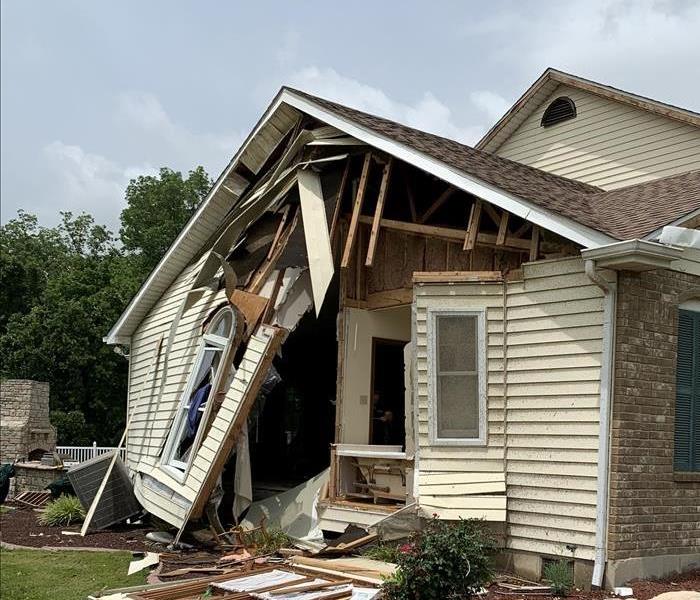 This is damage from a E1 tornado that passed through Farmington, MO.
This is damage from a E1 tornado that passed through Farmington, MO.
Keeping Buildings Dry During A Storm
If your building experiences a large storm, one of your main concerns will probably be water damage from the rain. This is because intense storms, such as thunderstorms and tornadoes, can create leaks and flood buildings. If you want to know how to avoid this, here are four tips for keeping your building dry during a storm.
- Use Building Envelopes
One of the best defenses against water damage is building envelopes. Essentially, building envelopes are what separate the interior and exterior of a building. Here are some things a building envelope does:
- Provides ventilation
- Keeps out water and wind
- Takes water away from the building
Be sure that your envelope is highly functional and able to keep out moisture.
- Clean Your Gutters
If your gutters are clogged during a storm, you may experience flooding in your building. This is particularly possible if you have a basement. Clogged gutters can also create damages on your roof and sidings, which might result in needing rain damage restoration services. Therefore, you should have your gutters cleaned regularly. - Trim Trees
The trees near your building could become highly dangerous during a storm. If tree branches break off because of a windstorm, you may find resulting holes in your structure, especially in your windows. This type of damage could allow water into your building and create rain damage. To avoid this, have nearby tree branches trimmed on a regular basis. - Reseal Your Doors
If your building is old, the seals on the doors may have become less effective. This is particularly possible if you work in a wetter climate. Take the time to look at the caulk surrounding your door. If you're unsure about its effectiveness, you may want to consult a professional.
To avoid dealing with any mold issues, vital to keep moisture out of your building. Protect your property by performing the necessary preparations.
Storm Ready Kit
8/4/2021 (Permalink)
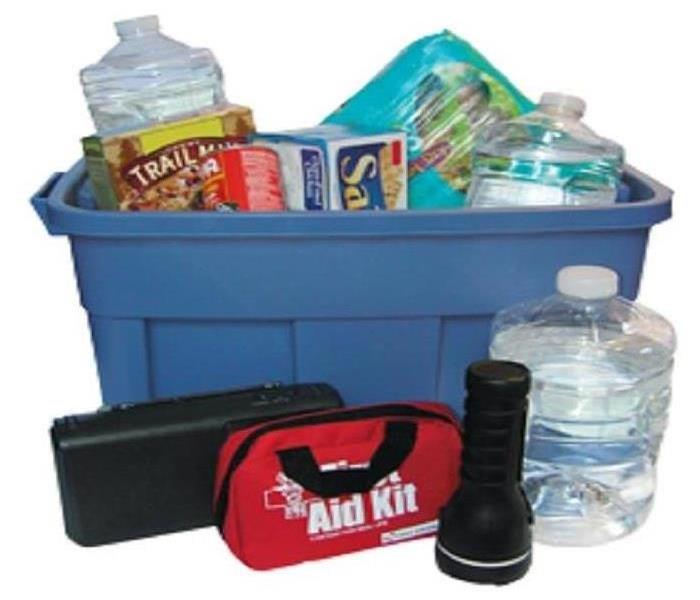 Always be prepared! Here's an idea of what a storm kit looks like!
Always be prepared! Here's an idea of what a storm kit looks like!
It feels as if we are constantly prepping for a storm - whether that is a tornado, thunderstorm, or even the rare winter storm that passes through the southeastern part of Missouri.
Our team at SERVPRO headquarters (HQ) has put together a list of basic household items you may want to keep in stock and store in a weather proof, safe place in case you find yourself in an emergency storm situation. We encourage checking on your items every 3 months to ensure they are in working order and haven't passed the expiration date.
Suggested items:
- Water- one gallon per person for at least three days.
- Food- at least a three day supply of non-perishable food.
- Battery powered or hand crank radio
- Flashlight.
- Extra batteries.
- Candles.
- Phone chargers.
- Road flares.
- Rain ponchos.
- Tarp.
- Wet wipes.
- A whistle to signal for help.
When you get caught in a storm, damage to your home is likely. It could be from a limb on your tree or rain leaking through a window. If you see any damage to your home due to a storm, call us at 573-756-5191 so we can help you through the mitigation process.
Spring Weather
4/13/2021 (Permalink)
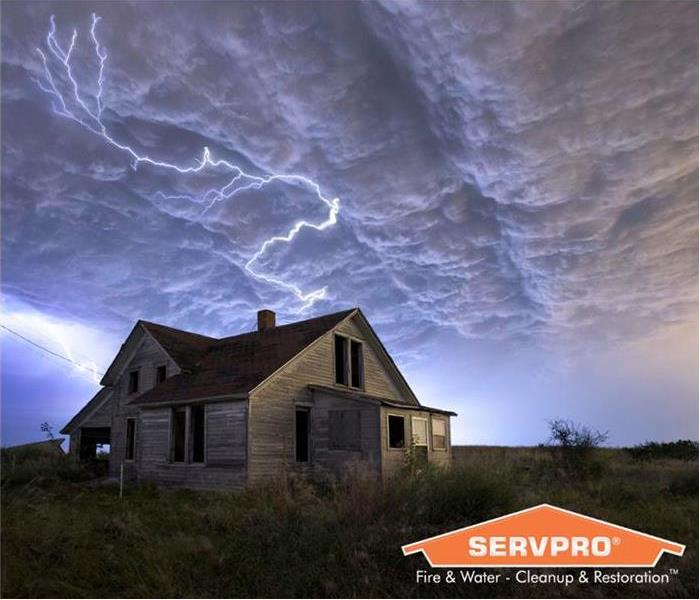 Storm damage? We can help, anytime!
Storm damage? We can help, anytime!
Spring is the time of year when many things change—including the weather. Temperatures can swing back and forth between balmy and frigid. Sunny days may be followed by a week of stormy weather. Sometimes extreme weather changes can occur even within the same day.
Thunderstorms cause most of the severe spring weather. They can bring lightning, tornadoes, and flooding. Whenever warm, moist air collides with cool, dry air, thunderstorms can occur. For much of the world, this happens in spring and summer.
Keep an emergency kit on hand. Prepare your family members for the possibility of severe weather. Tell them where to seek appropriate shelter as soon as they are aware of an approaching storm. Practice your emergency plan for every type of severe weather. Show family members where the emergency supplies are stored, and make sure they know how to turn off the water, gas, and electricity in your home.
Often by the time we are aware of an approaching storm, we have little if any time to prepare for it. But we do know that when spring arrives, thunderstorms, tornadoes, and floods are real possibilities. So why not take the surprise factor out of severe weather and prepare yourself, your family, and your home? If thunderstorms, tornadoes, and floods do occur, you’ll be ready for them. Should you need help after a severe storm, SERVPRO of Farmington is a phone call away at 573-756-5191.
Tornado Facts
8/21/2020 (Permalink)
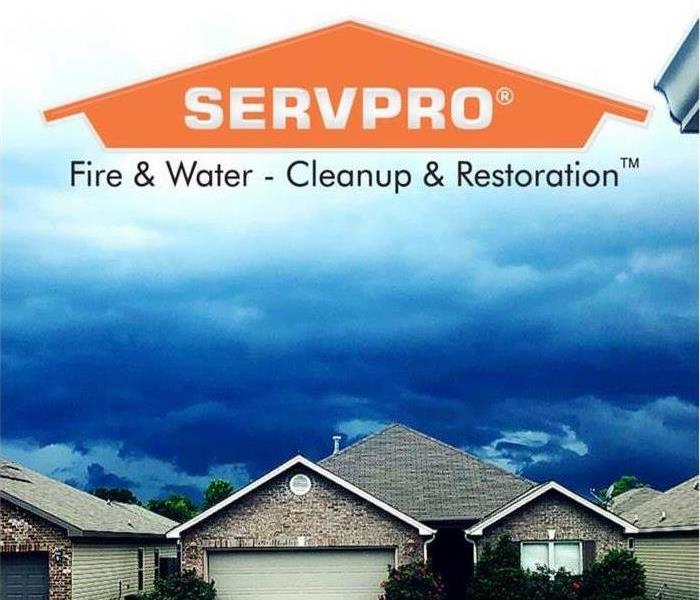 We are here to help with any type of storm damage you may have. Call us 573-756-5191.
We are here to help with any type of storm damage you may have. Call us 573-756-5191.
We all may think we know "enough" about tornadoes; I mean, they are big, scary, and UNWANTED. But, did you know.........
- The winds of a tornado can reach speeds of up to 480km per hour
- In extreme cases, tornadoes can last several hours and cross distances over 150km!
- Tornadoes are measured using the Fujita Scale (or F-scale), ranging from F0 to F5, with F5 being the strongest and most destructive.
- Most of the world’s tornadoes occur in the United States in what’s known as Tornado Alley. Stretching from West Texas to North Dakota, this area can see more than 200 tornadoes each year!
- Tornadoes can be invisible until they pick up dust and debris, or a cloud forms within the spinning funnel.
More facts about tornadoes can be found at https://www.natgeokids.com/za/discover/geography/physical-geography/tornado-facts/.
Our Storm Response
8/21/2020 (Permalink)
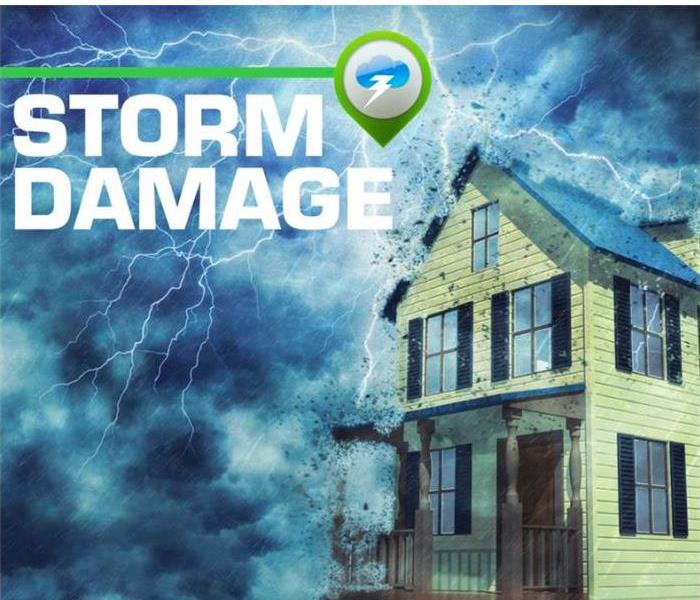 When a storm affects your home or business, call us 573-756-5191.
When a storm affects your home or business, call us 573-756-5191.
SERVPRO Storm Response
Our team here at SERVPRO of Farmington is ready for whatever happens, no matter the time of day. Our crews are always on standby. When it comes to fire and water damage, our professionals work tirelessly to make sure our customers are satisfied and are explained each step of the cleaning process.
Highly Trained Storm Damage Specialists
As leading professionals in the storm and water damage industry, we have advanced training and expertise, along with a tremendous amount of hands-on experience. We use this training and experience to quickly dry your home or business and restore it back to pre-storm condition.
Faster to Any Size Disaster
If a storm hits your home or business, odds are you need help immediately. Our quick response will help prevent any secondary damage and help reduce restoration costs.
We Have the Resources to Handle Storms and Disasters
Our team has access to resources and personnel of over 1,800 franchises to handle major storms and disasters. Our team also has access to our exclusive Disaster Recovery Teams strategically located to respond to catastrophic storms and events throughout the country.
Locally Owned and Operated
SERVPRO of Farmington is locally owned and operated. We are actively apart of the community with you as well. When you have a storm disaster or flooding emergency, we are in the area and ready to help you.
Lightning Causing House Fires
8/19/2020 (Permalink)
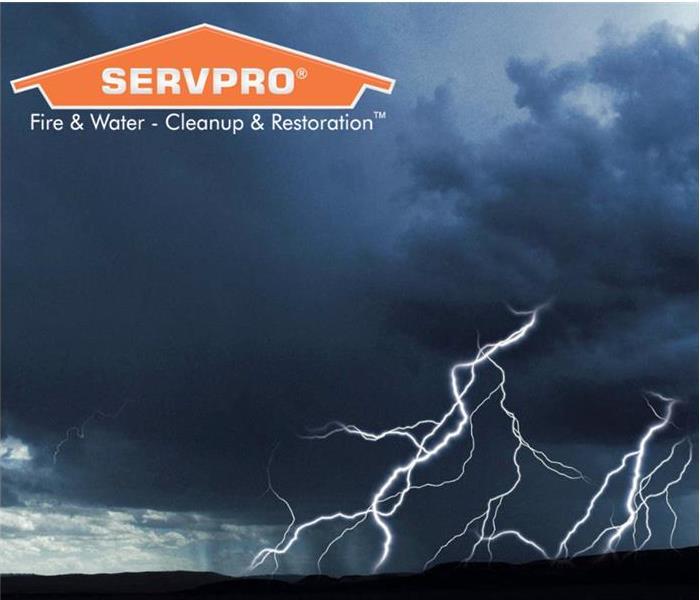 Have no fear, SERVPRO is here.
Have no fear, SERVPRO is here.
According to StormHighway.com:
A cloud-to-ground lightning bolt's main objective is to find the path of least resistance from the cloud to deep into the ground. Most houses are filled with many potential routes for lightning to follow in their journey. This can include gas and water pipes, electric lines, phone lines, cable TV/internet lines, gutters, downspouts, metal window frames - anything conductive in a house is 'fair game' for the lightning to follow.
Lightning passing through a house will often 'branch' and utilize more than one path to ground at a time. It can also jump through the air from one conductive path to another in what is called a side flash. For example, lightning may first connect to electric lines in the attic of a house, then jump to better-grounded water pipes on the first or second floor. Lightning can connect to gutters, then jump to a window frame as a 'stepping stone' to the electrical system or water pipes. All or part of bolts have been seen jumping from wall outlets to sink faucets and even across rooms!
The biggest danger lightning poses to a house is fire. Wood and other flammable building materials can easily be ignited anywhere an exposed lightning channel comes in contact with. It is most common for lightning to start a fire in the attic or roof of a house, as the channel usually has to pass through some of the structural material in the roof before it can reach a more conductive path such as wiring or pipes. When lightning current travels through wires, it will commonly burn them up - presenting a fire ignition hazard anywhere along the affected circuits.
SERVPRO of Farmington helps with water and fire remediation. Give us a call at 573-756-5191.
Storms
8/10/2020 (Permalink)
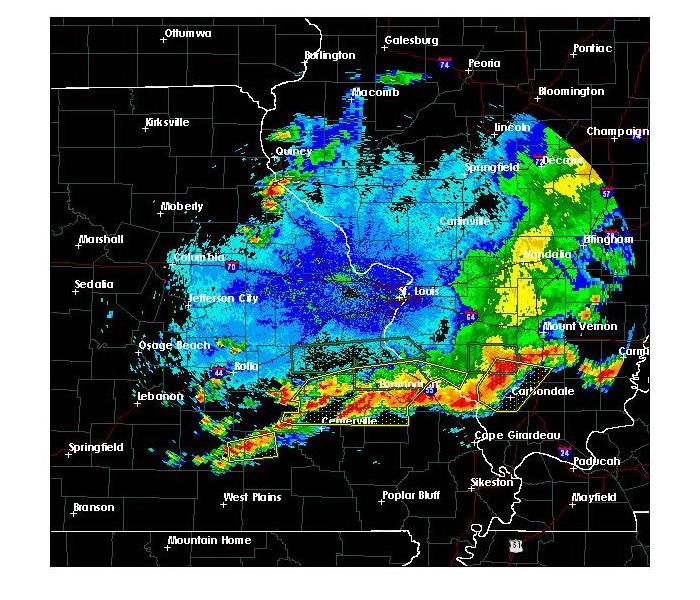 Storm damage? We can help!
Storm damage? We can help!
Thunderstorms are common throughout our servicing areas. Thankfully, practicing safety during these events can help reduce chances of damage to your property.
Severe thunderstorms can produce high winds, heavy rains, hail, and lightning.
Storm Safety outside your home:
Inspect you roof regularly for missing or loose shingles.
Clean your gutters at least twice yearly.
Bring in or secure patio furniture, potted plants or anything that could become projectiles in high winds.
Trim trees near your property to reduce dead limbs from falling.
Storm Safety inside your home:
Keep a radio, flashlight and batteries handy.
Have an emergency preparedness kit nearby.
Designate a safe room for your family to take shelter, it should be an interior room without windows.
Use surge protectors on every outlet in case of lightning strikes.
Being prepared can drastically reduce the damage severe weather can bring. If damage to your home or business does occur SERVPRO of Farmington is here to help 24/7!
Emergency Kit
8/5/2020 (Permalink)
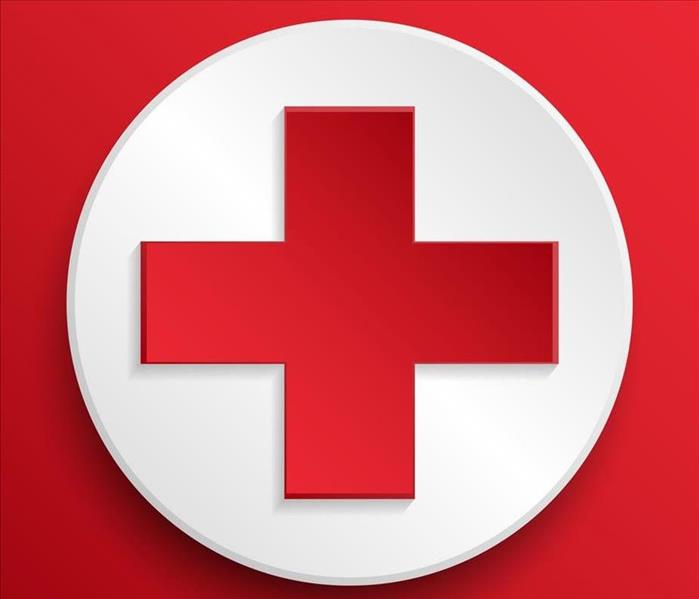 Being prepared is so important!
Being prepared is so important!
SERVPRO of Farmington is no stranger to storms, water damage, etc. The trained professionals there know that the possibilities are endless when it comes to any type of natural disaster or weather emergency, which is why we want to remind everyone in our servicing areas to have their emergency kits stocked and ready to go.
Here are some items that could be included in an emergency kit:
- Band-Aids
- Alcohol pads
- Scissors
- Tape
- Battery-powered radio and batteries
- Whistle if needed to signal for help
If pets are involved, tweak the emergency kit a bit to include pet food, a spare leash/collar, and other pet supplies that will be needed. Our servicing area is full of tech-savvy people who you could probably call for help if needed, but it is important to be prepared for when technology fails, especially when water is involved. If areas are flooded in any way, make sure to stay out of the water because electricity travel through water. That is why SERVPRO of Farmington urges you to have your kit ready if needed!
SERVPRO of Farmington is independently owned and operated.
Signs of Storm Damage
4/15/2020 (Permalink)
 Heavy rains caused this Farmington, MO home to take on water.
Heavy rains caused this Farmington, MO home to take on water.
After a storm rolls through, it is important to inspect your house for damage the storm may have caused. Listed below are areas you should be looking at.
- Roof: Look for shingles that have discoloration, tearing, or even holes in them. These can all be signs that your roof has been damaged. Another sign is if there are leaks in your roof or your ceiling.
- Gutters: After a hail storm, looking for dents or dings can also give you a better picture of what the storm did to the rest of your home. Your gutters can also give you insight to whether you have roof damage. Check to see if there are granules from the asphalt shingles in your gutter.
- Windows: Look at each of the windows on your homes and note any signs of shattered or broken window and frame damage. This is especially important after a hail storm or a strong wind storm.
- Exterior: Not only is it important to look at the siding of your home to check for damage, it is also important that you check all appliances. Inspect your AC/HVAC unit as well as items such as an outdoor grill.
After your inspection, if you notice any signs of storm damage follow up by checking the area for signs of mold, mildew, pests or other secondary damage. Our team is able to put an emergency roof tarp to prevent any further damage. Call SERVPRO of Farmington at 573-756-5191 for any restoration needs you may have.
Storm Facts
8/22/2019 (Permalink)
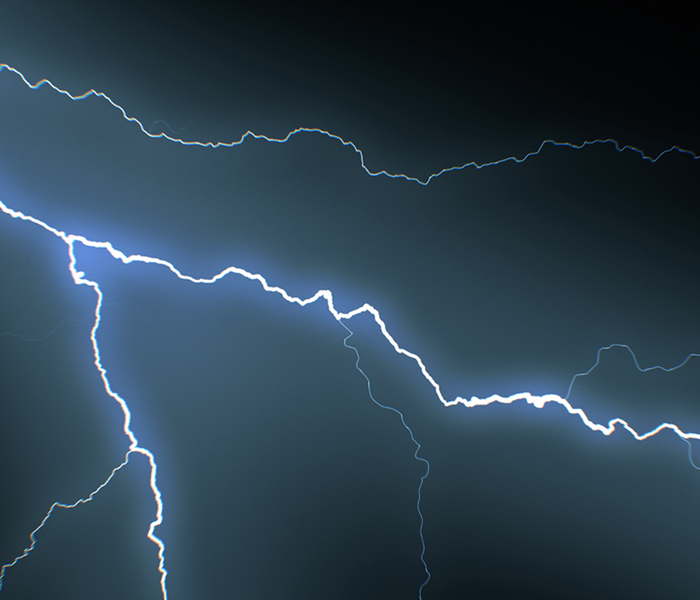 Lightening in the sky.
Lightening in the sky.
Are you afraid of storms, or do you embrace them? Whichever side you fall on, we all have some sort of respect for storms. They can cause great damage, paint beautiful pictures across the sky, alter any outdoor plans, and completely turn a day around. Although you’ve probably experienced many thunderstorms in your life, you might not know a whole lot about them. In today’s post, we’re going to share some fun storm facts that you may not have known!
The typical thunderstorm is 15 miles in diameter.
The typical thunderstorm lasts about 30 minutes.
About 1,800 thunderstorms are happening around the world at any given moment.
Lightning kills more people than tornadoes every year.
A severe storm “watch” means that a serious storm has the potential to develop but has not developed yet. However, a severe storm “warning” means that a storm has developed and been sighted.
About 10% of storms are classified as “severe”.
If you’re ever heard the term the “four horsemen” of thunderstorms, it’s referring to wind/tornadoes, hail, floods, and lightning.
Thunderstorm clouds grow to heights of above 20,000 feet.
A “derecho” is a type of severe storm that lasts a long time, covers a great distance, and involves serious wind.
Wind speeds can be up to 120 mph in thunderstorms, even without a tornado.
A massive hailstorm in Munich, Germany, in 1984 caused over $1 billion worth of damage.
In 1933, huge hailstones were reported to have fallen around a city in Massachusetts, containing fresh, frozen ducks inside.
Check Your Sump Pumps During Rainstorms
8/22/2019 (Permalink)
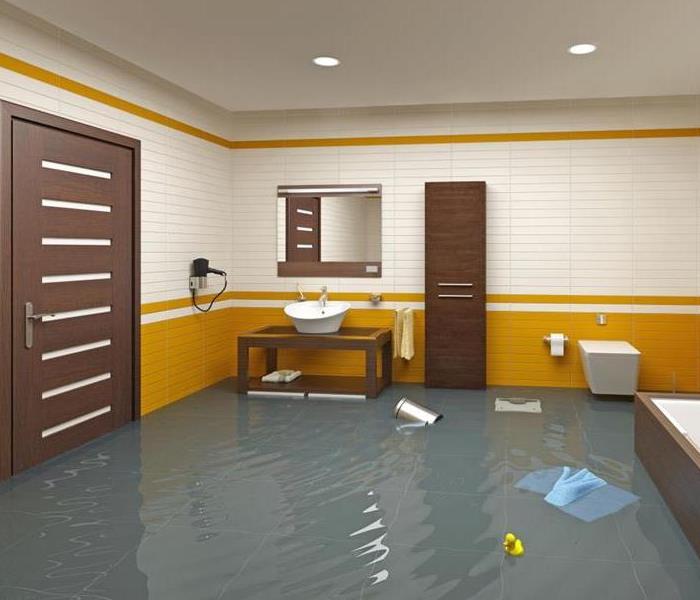 Sump pump fail? Call us 573-756-5191.
Sump pump fail? Call us 573-756-5191.
When the rain pours do you check your sump pump?
A proper working sump pump can save you considerable amounts of money after a significant rainfall event. Being a proactive owner during rainstorms and checking your home or businesses sump pump will help prevent damage or reduce the damage that can occur. When damage happens SERVPRO of Farmington is here to help.
If you answered no to the first question here are some things to consider checking:
- Is there power to the sump pump? Check that it is plugged in and the breaker is not tripped.
- Is the float free of any debris and away from the side wall where it won’t work properly?
- Is the inlet free of any debris that could prevent it from pumping the water out?
- Does the pump work? An easy way to test this is by filling the pit with enough water to reach the float of the sump pump to trigger the pump.
- Check where the sump pump drains. Ensure that it drains far enough from the foundation that the water doesn't leak right back in.
Storms vs. SERVPRO
8/21/2019 (Permalink)
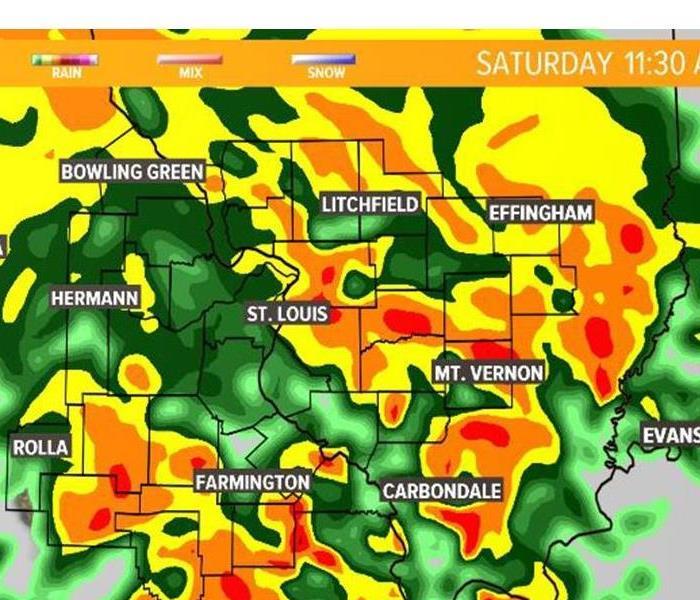 Storm Damage? We can help!
Storm Damage? We can help!
Every year, SERVPRO of Farmington answers the call to help clean up and restore homes and businesses after storms have taken their toll. After all, SERVPRO of Farmington is always here in helping make disasters “Like it never even happened.” when your property suffers from storm damage. So, leave the restoration remediation of your home and business to our team. Consider the following to protect your property during a storm:
Myth: If it is not raining, then there is no danger from lighting.
Fact: Lightning often strikes outside of heavy rain and may occur as far as 10 miles away from rainfall.
Myth: Rubber soles of shoes or rubber tires on a car protect you from being struck.
Fact: Rubber-soled shoes and rubber tires provide no protection from lightning. The steel frame of a hard-topped vehicle provides increased protection if you are not toughing metal. Although you may be injured if lightning strikes your car, you are much safer inside a vehicle than outside.
Myth: “Heat lightning” occurs after very hot summer days and poses no threat.
Fact: “Heat lightning” is a team used to describe lightning from a thunderstorm too far away for thunder to be heard.
When disaster strikes, SERVPRO of Farmington is here to help you. Give our team of professionals a call 573-756-5191!
Storm Damage? No problem!
8/12/2019 (Permalink)
 When lightning strikes, SERVPRO of Farmington strikes back! Storm Damage? Leave it to the pros.
When lightning strikes, SERVPRO of Farmington strikes back! Storm Damage? Leave it to the pros.
Mother nature is so unpredictable. You never know when a natural disaster is going to strike. Storms are commonly known for destroying one’s home or business and as a normal human being, it may cause someone to panic. But don't feel under the weather when a storm hits because SERVPRO is faster than any disaster. We will respond and start the restoration of your property quickly and efficiently. A long the way, SERVPRO’S certified professionals will reassure you that everything will be fine with their work ethics.
SERVPRO of Farmington technicians are properly trained and can take on any type of storm disaster. They will inspect the extent of the damages and come up with the proper strategies for the specific damages. As the restoration is in process, SERVPRO of Farmington will keep in mind the distress the customer may be feeling and work diligently to provide the best services as quickly as possible so the customer can go back to living their normal lives.
One thing SERVPRO knows for sure is how to take care of fire, water and mold damages.
When a storms hit, don't panic!
Call SERVPRO of Farmington at 573-756-5191.
Storm Damage? No worries!
8/8/2019 (Permalink)
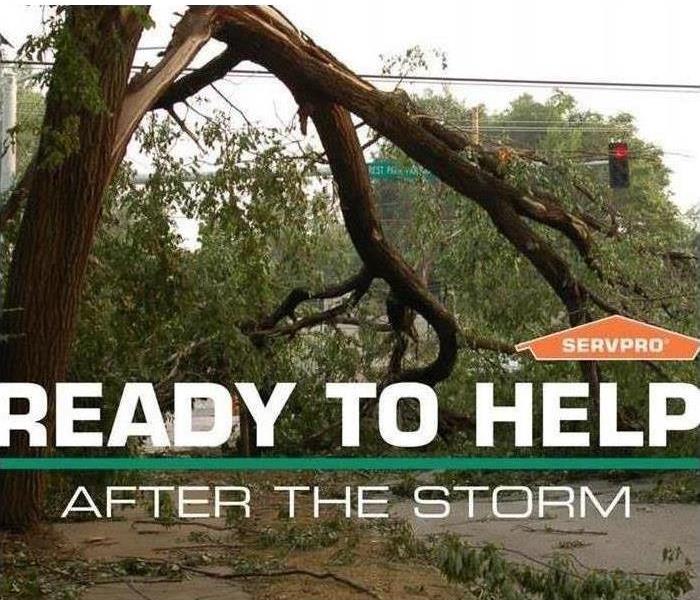 No matter if it's day or night, SERVPRO of Farmington is ready to help.
No matter if it's day or night, SERVPRO of Farmington is ready to help.
If you come home to find standing ground water and flooding in your home, chances are you'll feel frustrated. You may think you can handle the ground water yourself. It's important that you avoid trying to repair your house on your own and let a SERVPRO restoration expert that has the experience and the tools to repair your home. The SERVPRO restoration expert can help you with a variety of issues, including:
- Flooding
- Roof damage
- Roof leak
- Wind damage
- General storm damage
Never wait to pursue help for storm damage especially if the damage involves a roof repair. A roof leak is a serious issue that can arise after storm damage or wind damage. Roof damage can also occur as a result of wind damage. Roof damage that leads to a roof leak can cause a variety of issues, including interior damage to your home. The SERVPRO restoration expert can help you with roof repair and other storm remediation. Remember that it's important to get home restoration assistance as soon as possible.
Call SERVPRO of Farmington today if you experience storm damage at 573-756-5191.
“Like it never even happened.”
Is Your Farmington Home Storm Ready?
4/24/2019 (Permalink)
As anyone who lives here knows, springtime in Farmington brings beautiful sunshine as well as strong rain and wind storms. With weather that can switch so quickly between the two, it’s important to make sure your home is storm-ready, prepared to handle and withstand unpredictable conditions.
It’s always a good idea to conduct a home and ground inspection before weather conditions take a turn for the worst. Things like leaky roofs or windows can be very problematic in the midst of heavy rainfall and strong winds, so checking them and making sure they are all fitted correctly is a critical step to take.
Checking for loose shutters and trimming back any trees or shrubbery that may be surrounding your home is another good way to get it storm-ready. Shutters, tree limbs, and other loose debris can get picked up by wind and thrown in any direction, including towards your house. Also inspect any drainage areas near or around your home, clearing them of any debris that may be creating blockage. This will help reduce chances of flooding your property during a storm.
Another thing to consider when preparing your home for a storm is what kind of system to have in place that will allow you to communicate with your loved ones and receive weather updates. In some cases, storms can become strong enough to put your cell phone’s service signal at risk, so it’s good to be prepared and have an alternative form of communication in place.
And as always, in the event of storm damage SERVPRO of Farmington is here to help. We’re available 24/7 and ready when you need us. Give us a call at (573) 756-5191.
SERVPRO Storm
8/21/2018 (Permalink)
Storms and inclement weather can bring wind damage, heavy rain, and flooding that can devastate any business in a matter of minutes. There’s never a convenient time for flooding or water damage to strike, and storms don’t just strike during regular business hours; that’s why SERVPRO Franchise Professionals offer 24 hour emergency service 365 days per year.
Every hour spent cleaning up is an hour of lost revenue and productivity. So when an emergency situation arises in your business, give our Professionals a call and they’ll be there fast with the help you need.
- 24 Hour Emergency Service
- Faster to Any Size Disaster
- A Trusted Leader in the Storm and Water Restoration Industry with over 1,700 Franchises
- Highly Trained Storm and Water Damage Restoration Specialists
Storm or Flood Damage? Call Us Today 573-756-5191
The SERVPRO System has a network of strategically positioned storm teams on standby should a disaster strike near you. Available 24 hours a day and 365 days a year, SERVPRO Franchise Professionals are prepared for the unpredictable.
We make it look "Like it never even happened."
Storms & SERVPRO
8/15/2018 (Permalink)
Watch vs. Warning
A severe thunderstorm watch means that the potential exists for the development of thunderstorms which may produce large hail or damaging winds. A watch is issued by the SPC (Storm Prediction Center).
A severe thunderstorm warning means that a severe thunderstorm is occurring or is imminent based on Doppler radar information or a reliable spotter report. A warning is issued by the local National Weather Service office.
_______________________________________
Watch vs. Warning and Storm Basics are provided by NOAA (National Oceanic and Atmospheric Administration). For more information visit their website: www.noaa.gov
Storm Basics
A thunderstorm is a rain shower which you hear thunder. Since thunder comes from lightning, all thunderstorms have lightning.
A thunderstorm is classified as "severe" when it contains one or more of the following:
- Hail (One inch or greater)
- Winds in excess of 58 mph
- Structural wind damage
- Tornado
Tornado Facts
Tornadoes are arguably nature’s most violent storms. Generated from powerful thunderstorms, tornadoes generally appear as rotating, funnel-shaped clouds extending from the cloud base to the ground. With winds that can reach up to 300 miles per hour, tornadoes can cause massive destruction within seconds. Damage paths can be in excess of one mile wide and fifty miles long.
- The average tornado moves southwest to northeast, but tornadoes have been known to move in any direction.
- The average forward speed of a tornado is 30 miles per hour, but may vary from stationary to 70 miles per hour.
- Tornadoes can accompany tropical storms and hurricanes as they move onto land.
- Tornadoes are most frequently reported east of the Rocky Mountains during spring and summer months.
- Tornadoes are most likely to occur between 3 p.m. and 9 p.m.
Before the Storm
- To begin preparing, you should build an emergency supply kit and make a family communication plan.
- Remove dead or rotting trees and branches that could fall and cause injury or damage during a severe thunderstorm.
- Postpone outdoor activities. n Remember the 30/30 Lightning Safety Rule: Go indoors if, after seeing lightning, you cannot count to 30 before hearing thunder. Stay indoors for 30 minutes after hearing the last clap of thunder.
- Secure outdoor objects that could blow away or cause damage.
- Get inside a home, building, or hard top automobile (not a convertible). Although you may be injured if lightning strikes your car, you are much safer inside a vehicle than outside.
- Remember, rubber-soled shoes and rubber tires provide NO protection from lightning. However, the steel frame of a hard-topped vehicle provides increased protection if you are not touching metal.
- Shutter windows and secure outside doors. If shutters are not available, close window blinds, shades or curtains.
- Unplug any electronic equipment well before the storm arrives.
During the Storm
- Use your battery-operated NOAA Weather Radio for updates from local officials.
- Avoid contact with corded phones. Use a corded telephone only for emergencies. Cordless and cellular telephones are safe to use.
- Avoid contact with electrical equipment or cords. Unplug appliances and other electrical items such as computers and turn off air conditioners. Power surges from lightning can cause serious damage.
- Avoid contact with plumbing. Do not wash your hands, do not take a shower, do not wash dishes, and do not do laundry. Plumbing and bathroom fixtures can conduct electricity.
- Stay away from windows and doors, and stay off porches.
- Do not lie on concrete floors and do not lean against concrete walls.
- Avoid natural lightning rods such as a tall, isolated tree in an open area.
- Avoid hilltops, open fields, the beach or a boat on the water.
- Take shelter in a sturdy building. Avoid isolated sheds or other small structures in open areas.
- Avoid contact with anything metal—tractors, farm equipment, motorcycles, golf carts, golf clubs, and bicycles.
- If you are driving, try to safely exit the roadway and park. Stay in the vehicle and turn on the emergency flashers until the heavy rain ends. Avoid touching metal or other surfaces that conduct electricity in and outside the vehicle.
After the Storm
- Never drive through a flooded roadway.
- Stay away from storm-damaged areas to keep from putting yourself at risk from the effects of severe thunderstorms.
- Continue to listen to a NOAA Weather Radio or to local radio and television stations for updated information or instructions, as access to roads or some parts of the community may be blocked.
- Help people who may require special assistance, such as infants, children and the elderly or those with access or functional needs.
- Stay away from downed power lines and report them immediately. n Watch your animals closely. Keep them under your direct control.
- If you have storm damage to your home or property, call SERVPRO of Farmington. Timely mitigation is key to minimize secondary damages caused by severe storms.
SERVPRO of Farmington Services
Unexpected emergencies like severe weather call for immediate action. SERVPRO of Farmington knows immediate reaction to the disaster is important to helping you get your life back to normal.
Utilizing our 1-4-8 Service Response Guidelines*, SERVPRO of Farmington strives to:
- Contact you within 1 hour from notice of loss to arrange for service.
- Be on-site to begin mitigation services within 4 hours of notification.
- Provide verbal briefing of scope to you within 8 business hours of on-site arrival.
SERVPRO of Farmington can also perform pack-out services, which is removing salvageable personal property from the affected area for off-site cleaning and storage.
_______________________________________
*Exceptions may apply under certain conditions, such as a local catastrophic event or storm situation.
Storm Basics 101
8/6/2018 (Permalink)
Watch vs. Warning
A severe thunderstorm watch means that the potential exists for the development of thunderstorms which may produce large hail or damaging winds. A watch is issued by the SPC (Storm Prediction Center).
A severe thunderstorm warning means that a severe thunderstorm is occurring or is imminent based on Doppler radar information or a reliable spotter report. A warning is issued by the local National Weather Service office.
_______________________________________
Watch vs. Warning and Storm Basics are provided by NOAA (National Oceanic and Atmospheric Administration). For more information visit their website: www.noaa.gov
Storm Basics
A thunderstorm is a rain shower which you hear thunder. Since thunder comes from lightning, all thunderstorms have lightning.
A thunderstorm is classified as "severe" when it contains one or more of the following:
- Hail (One inch or greater)
- Winds in excess of 58 mph
- Structural wind damage
- Tornado
Tornado Facts
Tornadoes are arguably nature’s most violent storms. Generated from powerful thunderstorms, tornadoes generally appear as rotating, funnel-shaped clouds extending from the cloud base to the ground. With winds that can reach up to 300 miles per hour, tornadoes can cause massive destruction within seconds. Damage paths can be in excess of one mile wide and fifty miles long.
- The average tornado moves southwest to northeast, but tornadoes have been known to move in any direction.
- The average forward speed of a tornado is 30 miles per hour, but may vary from stationary to 70 miles per hour.
- Tornadoes can accompany tropical storms and hurricanes as they move onto land.
- Tornadoes are most frequently reported east of the Rocky Mountains during spring and summer months.
- Tornadoes are most likely to occur between 3 p.m. and 9 p.m.
Before the Storm
- To begin preparing, you should build an emergency supply kit and make a family communication plan.
- Remove dead or rotting trees and branches that could fall and cause injury or damage during a severe thunderstorm.
- Postpone outdoor activities. n Remember the 30/30 Lightning Safety Rule: Go indoors if, after seeing lightning, you cannot count to 30 before hearing thunder. Stay indoors for 30 minutes after hearing the last clap of thunder.
- Secure outdoor objects that could blow away or cause damage.
- Get inside a home, building, or hard top automobile (not a convertible). Although you may be injured if lightning strikes your car, you are much safer inside a vehicle than outside.
- Remember, rubber-soled shoes and rubber tires provide NO protection from lightning. However, the steel frame of a hard-topped vehicle provides increased protection if you are not touching metal.
- Shutter windows and secure outside doors. If shutters are not available, close window blinds, shades or curtains.
- Unplug any electronic equipment well before the storm arrives.
During the Storm
- Use your battery-operated NOAA Weather Radio for updates from local officials.
- Avoid contact with corded phones. Use a corded telephone only for emergencies. Cordless and cellular telephones are safe to use.
- Avoid contact with electrical equipment or cords. Unplug appliances and other electrical items such as computers and turn off air conditioners. Power surges from lightning can cause serious damage.
- Avoid contact with plumbing. Do not wash your hands, do not take a shower, do not wash dishes, and do not do laundry. Plumbing and bathroom fixtures can conduct electricity.
- Stay away from windows and doors, and stay off porches.
- Do not lie on concrete floors and do not lean against concrete walls.
- Avoid natural lightning rods such as a tall, isolated tree in an open area.
- Avoid hilltops, open fields, the beach or a boat on the water.
- Take shelter in a sturdy building. Avoid isolated sheds or other small structures in open areas.
- Avoid contact with anything metal—tractors, farm equipment, motorcycles, golf carts, golf clubs, and bicycles.
- If you are driving, try to safely exit the roadway and park. Stay in the vehicle and turn on the emergency flashers until the heavy rain ends. Avoid touching metal or other surfaces that conduct electricity in and outside the vehicle.
After the Storm
- Never drive through a flooded roadway.
- Stay away from storm-damaged areas to keep from putting yourself at risk from the effects of severe thunderstorms.
- Continue to listen to a NOAA Weather Radio or to local radio and television stations for updated information or instructions, as access to roads or some parts of the community may be blocked.
- Help people who may require special assistance, such as infants, children and the elderly or those with access or functional needs.
- Stay away from downed power lines and report them immediately. n Watch your animals closely. Keep them under your direct control.
- If you have storm damage to your home or property, call SERVPRO of Farmington. Timely mitigation is key to minimize secondary damages caused by severe storms.
SERVPRO of Farmington Services
Unexpected emergencies like severe weather call for immediate action. SERVPRO of Farmington knows immediate reaction to the disaster is important to helping you get your life back to normal.
Utilizing our 1-4-8 Service Response Guidelines*, SERVPRO of Farmington strives to:
- Contact you within 1 hour from notice of loss to arrange for service.
- Be on-site to begin mitigation services within 4 hours of notification.
- Provide verbal briefing of scope to you within 8 business hours of on-site arrival.
SERVPRO of Farmington can also perform pack-out services, which is removing salvageable personal property from the affected area for off-site cleaning and storage.
_______________________________________
*Exceptions may apply under certain conditions, such as a local catastrophic event or storm situation.
Flood Water
8/1/2018 (Permalink)
Flood Watch
Flooding is possible. Listen to weather radio, commercial radio, or TV for information.
Flash Flood Watch
Flash flooding is possible. Be prepared to move to higher ground; listen to weather radio, commercial radio, or TV for information.
Flood Warning
Flooding is occurring or will occur soon; if advised to evacuate, do so immediately.
Flash Flood Warning
A flash flood is occurring; seek higher ground on foot immediately.
Floods Strike Everywhere!
Floods rank as one of the most common and widespread natural disasters in the United States. Whether you live near a coastline, along city streets, in the mountains, near a river or even in the desert, there is a potential for suffering flood damage. In fact, nearly 25% of last year’s claims paid by the National Flood Insurance Program (NFIP) were for policies in moderate to low-risk communities.1 According to the NFIP, houses in the United States have a 26% chance of being damaged by a flood during the course of a 30-year mortgage, while businesses face similar risks by flooding.1 On average, floods cost $6 billion in annual losses in the U.S. The following are a few more little-known flood facts:
- Floods kill an average of 140 people per year in the U.S., making flooding the most deadly natural disaster.
- More than half of all fatalities during floods are auto related, often the result of drivers misjudging the depth of water on a road and being swept away in a swiftly moving current.
- The principle causes of floods in the eastern United States are hurricanes and storms.
- The principle causes of floods in the western United States are snow melt and rainstorms.
If a flood does strike your home or business, give SERVPRO of Farmington a call. Even minor floods have the potential to cause major damage to a structure when not treated quickly and properly, and the cleanup is often an overwhelming task. SERVPRO of Farmington is prepared to handle any size disaster and help make it “Like it never even happened.”
Winter Weather: Coming Soon
8/1/2018 (Permalink)
Winter weather will be here before we know it!
Prepare your home!
- Keep cabinet doors open during cold spells. This allows warm air to circulate around pipes.
- Keep a slow trickle of water flowing through faucets, especially if the pipes for faucets run through unheated or uninsulated areas of your home.
- Consider shutting off outdoor faucets. Find the shut-off valve in the basement or crawl space and turn it to “off .”
- If you follow the previous step, then open the outdoor faucet to help ensure it drains completely and the inner valve is shut off.
- Ensure gutters are clean and secure. Leaves and debris accumulate, causing a damming effect on gutters, which could lead to roof problems and water damage.
- Proper maintenance of your furnace can help reduce the risk of puffbacks.
Frozen Pipes
A frozen pipe can burst at the point where the ice blockage inside the pipe is located, but typically the rupture is caused by the backflow pressure between the water source and the blockage. A burst pipe can cause considerable damage to your property if not addressed quickly. SERVPRO of Farmington is faster to any size disaster, bringing the latest equipment and training to help make your water damage “Like it never even happened.”
Ice Dams
Ice dams can be a major problem during the winter season. They form when heated air melts roof snow downward into water dammed behind still-frozen ice. When the trapped water cannot safely flow or run into the gutter system, it can backflow under the roof’s shingles and into the structure’s interior areas. SERVPRO of Farmington can help mitigate water damage caused by ice dams and help you get your structure back to preloss condition.
Puffbacks
A puff back is a messy furnace malfunction that occurs when an oil burner backfires, sending soot throughout your home or business. It can happen all at once, covering an interior in grimy soot, or a puff back can leak soot particles more gradually. Equipped with the training, tools and experience to quickly and efficiently clean and restore your home or business, SERVPRO of Farmington will help make your puff back “Like it never even happened.”
April Showers bring May Flowers
4/6/2018 (Permalink)
Watch vs. Warning
A severe thunderstorm watch means that the potential exists for the development of thunderstorms which may produce large hail or damaging winds. A watch is issued by the SPC (Storm Prediction Center).
A severe thunderstorm warning means that a severe thunderstorm is occurring or is imminent based on Doppler radar information or a reliable spotter report. A warning is issued by the local National Weather Service office.
_______________________________________
Watch vs. Warning and Storm Basics are provided by NOAA (National Oceanic and Atmospheric Administration). For more information visit their website: www.noaa.gov
Storm Basics
A thunderstorm is a rain shower which you hear thunder. Since thunder comes from lightning, all thunderstorms have lightning.
A thunderstorm is classified as "severe" when it contains one or more of the following:
- Hail (One inch or greater)
- Winds in excess of 58 mph
- Structural wind damage
- Tornado
Tornado Facts
Tornadoes are arguably nature’s most violent storms. Generated from powerful thunderstorms, tornadoes generally appear as rotating, funnel-shaped clouds extending from the cloud base to the ground. With winds that can reach up to 300 miles per hour, tornadoes can cause massive destruction within seconds. Damage paths can be in excess of one mile wide and fifty miles long.
- The average tornado moves southwest to northeast, but tornadoes have been known to move in any direction.
- The average forward speed of a tornado is 30 miles per hour, but may vary from stationary to 70 miles per hour.
- Tornadoes can accompany tropical storms and hurricanes as they move onto land.
- Tornadoes are most frequently reported east of the Rocky Mountains during spring and summer months.
- Tornadoes are most likely to occur between 3 p.m. and 9 p.m.
Before the Storm
- To begin preparing, you should build an emergency supply kit and make a family communication plan.
- Remove dead or rotting trees and branches that could fall and cause injury or damage during a severe thunderstorm.
- Postpone outdoor activities. n Remember the 30/30 Lightning Safety Rule: Go indoors if, after seeing lightning, you cannot count to 30 before hearing thunder. Stay indoors for 30 minutes after hearing the last clap of thunder.
- Secure outdoor objects that could blow away or cause damage.
- Get inside a home, building, or hard top automobile (not a convertible). Although you may be injured if lightning strikes your car, you are much safer inside a vehicle than outside.
- Remember, rubber-soled shoes and rubber tires provide NO protection from lightning. However, the steel frame of a hard-topped vehicle provides increased protection if you are not touching metal.
- Shutter windows and secure outside doors. If shutters are not available, close window blinds, shades or curtains.
- Unplug any electronic equipment well before the storm arrives.
During the Storm
- Use your battery-operated NOAA Weather Radio for updates from local officials.
- Avoid contact with corded phones. Use a corded telephone only for emergencies. Cordless and cellular telephones are safe to use.
- Avoid contact with electrical equipment or cords. Unplug appliances and other electrical items such as computers and turn off air conditioners. Power surges from lightning can cause serious damage.
- Avoid contact with plumbing. Do not wash your hands, do not take a shower, do not wash dishes, and do not do laundry. Plumbing and bathroom fixtures can conduct electricity.
- Stay away from windows and doors, and stay off porches.
- Do not lie on concrete floors and do not lean against concrete walls.
- Avoid natural lightning rods such as a tall, isolated tree in an open area.
- Avoid hilltops, open fields, the beach or a boat on the water.
- Take shelter in a sturdy building. Avoid isolated sheds or other small structures in open areas.
- Avoid contact with anything metal—tractors, farm equipment, motorcycles, golf carts, golf clubs, and bicycles.
- If you are driving, try to safely exit the roadway and park. Stay in the vehicle and turn on the emergency flashers until the heavy rain ends. Avoid touching metal or other surfaces that conduct electricity in and outside the vehicle.
After the Storm
- Never drive through a flooded roadway.
- Stay away from storm-damaged areas to keep from putting yourself at risk from the effects of severe thunderstorms.
- Continue to listen to a NOAA Weather Radio or to local radio and television stations for updated information or instructions, as access to roads or some parts of the community may be blocked.
- Help people who may require special assistance, such as infants, children and the elderly or those with access or functional needs.
- Stay away from downed power lines and report them immediately. n Watch your animals closely. Keep them under your direct control.
- If you have storm damage to your home or property, call SERVPRO of Farmington. Timely mitigation is key to minimize secondary damages caused by severe storms.
SERVPRO of Farmington Services
Unexpected emergencies like severe weather call for immediate action. SERVPRO of Farmington knows immediate reaction to the disaster is important to helping you get your life back to normal.
Utilizing our 1-4-8 Service Response Guidelines*, SERVPRO of Farmington strives to:
- Contact you within 1 hour from notice of loss to arrange for service.
- Be on-site to begin mitigation services within 4 hours of notification.
- Provide verbal briefing of scope to you within 8 business hours of on-site arrival.
SERVPRO of Farmington can also perform pack-out services, which is removing salvageable personal property from the affected area for off-site cleaning and storage.
_______________________________________
*Exceptions may apply under certain conditions, such as a local catastrophic event or storm situation.
Tips For Working With Your Insurance
8/9/2017 (Permalink)
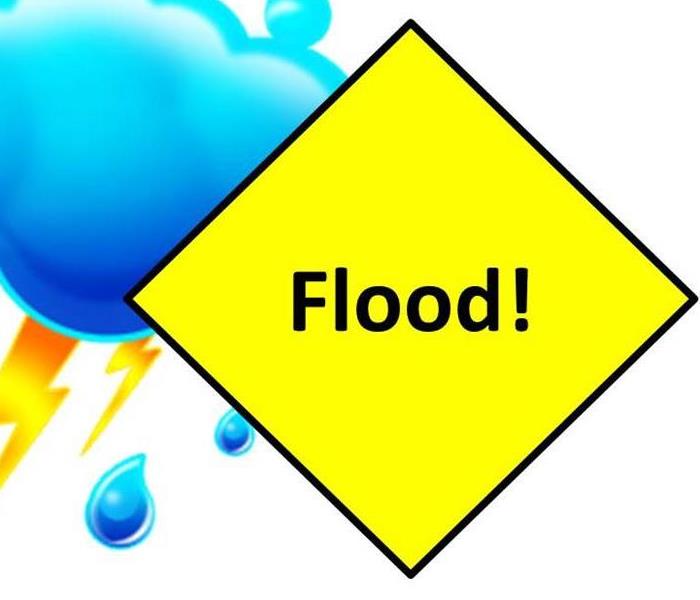 Call us today! 573-756-5191
Call us today! 573-756-5191
Regular life is stressful enough, but if you are surprised with flooding or other water damage in your home, everyone in the household will be stressed. Whether flood damage leaves carpeting soaked and soggy or you have come back to a disaster after evacuation, severe weather and damaged pipes will cause significant worry about how to start putting back together your daily life.
However, you can prepare for these unknowns by knowing what to expect and create a plan in case of emergency. To assist you, SERVPRO of Farmington has put together this mini-guide to help you understand the flood insurance claim process.
The first thing you will want to do is call your insurance provider. Although the U.S. government funds the National Flood Insurance Program (NFIP), local home and rental insurance companies are the exclusive sellers of Flood Damage Insurance. While you will be working directly with an insurance agent, SERVPRO can also serve as a liaison, helping you to navigate through the claims process.
After your initial call to your insurance company, contact your Farmington SERVPRO at 573-756-5191. We are available every day, all day, to handle your emergencies. Even if you are not able to reach your insurance agent immediately, SERVPRO will take your call and begin to work with you on first response remediation solutions. Have questions about what to do first or what items can be restored? SERVPRO is here to answer those questions and more! Our compassionate team understands your distress and will guide you through the storm damage restoration process.
Now you can begin your water damage restoration. We pride ourselves on having the fastest response time to storm damage in your area. We will arrive at your home prepared to conduct an inspection and moisture readings, create a scope of the damage and provide an estimate for you and your insurance provider. Our team will arrive prepared and ready to start immediately. We can store and access your information easily and quickly.
Our SERVPRO team members are the premier flood and water damage restoration experts in Farmington and surrounding areas. We are also the preferred remediation team for home insurance providers, and the most trusted helper for storm disasters. Storm damage restoration and navigating flood insurance claims can feel stressful, but we are here to assist you with every stage of the recovery process.
For emergencies and other situations, call 573-756-5191 anytime to reach your area flood damage experts, SERVPRO of Farmington. We help residential and commercial property owners when natural disasters, water damage, sewer backups, floods, mold infestations, fires and other events happen.
Storm Damage- Like it never even happened.
8/9/2017 (Permalink)
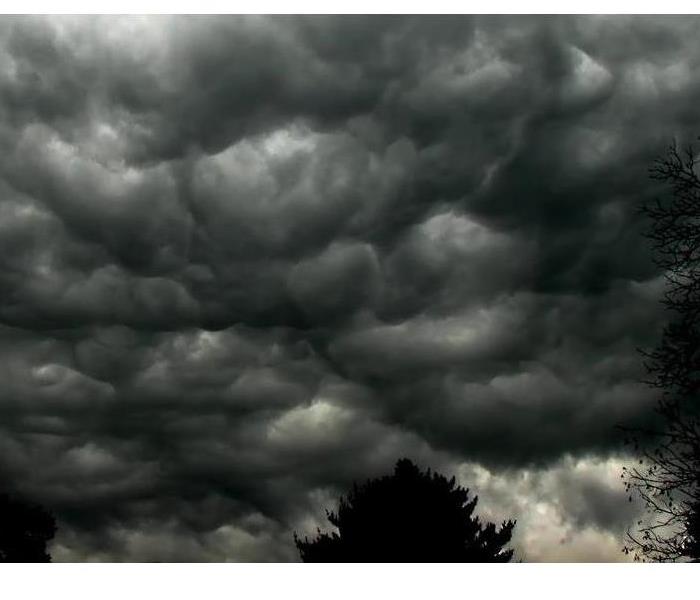 Call us today for all your storm damage needs! 573-756-5191
Call us today for all your storm damage needs! 573-756-5191
When mother nature is at her absolute worst, SERVPRO of Farmington is at its best! Immediate response, expert assessment and specialized equipment are paramount in the aftermath of a severe storm or wind damage. As with any of our core services, SERVPRO of Farmington takes extra special care in salvaging and restoring any property that may have been affected.
Severe weather never sleeps and neither do we! SERVPRO of Farmington is always a mere phone call away when disaster strikes. Our Storm Response Team travels nationally to any area devastated by natural disaster. Give us a call at 573-756-5191 or check out our other storm blogs! Our crews will make it "Like it never even happened."
Do you have storm damage? Call us today at 573-756-5191.
When the flood waters rise, so do we!
7/25/2017 (Permalink)
 This was a customer's basement when the heavy rain happened on 4/30/17. The heavy rains cause heavy flooding throughout our servicing counties.
This was a customer's basement when the heavy rain happened on 4/30/17. The heavy rains cause heavy flooding throughout our servicing counties.
Flood Watch
Flooding is possible. Listen to weather radio, commercial radio, or TV for information.
Flash Flood Watch
Flash flooding is possible. Be prepared to move to higher ground; listen to weather radio, commercial radio, or TV for information.
Flood Warning
Flooding is occurring or will occur soon; if advised to evacuate, do so immediately.
Flash Flood Warning
A flash flood is occurring; seek higher ground on foot immediately.
Floods Strike Everywhere!
Floods rank as one of the most common and widespread natural disasters in the United States. Whether you live near a coastline, along city streets, in the mountains, near a river or even in the desert, there is a potential for suffering flood damage. In fact, nearly 25% of last year’s claims paid by the National Flood Insurance Program (NFIP) were for policies in moderate to low-risk communities.1 According to the NFIP, houses in the United States have a 26% chance of being damaged by a flood during the course of a 30-year mortgage, while businesses face similar risks by flooding.1 On average, floods cost $6 billion in annual losses in the U.S. The following are a few more little-known flood facts:
- Floods kill an average of 140 people per year in the U.S., making flooding the most deadly natural disaster.
- More than half of all fatalities during floods are auto related, often the result of drivers misjudging the depth of water on a road and being swept away in a swiftly moving current.
- The principle causes of floods in the eastern United States are hurricanes and storms.
- The principle causes of floods in the western United States are snow melt and rainstorms.
If a flood does strike your home or business, give SERVPRO of Farmington a call. Even minor floods have the potential to cause major damage to a structure when not treated quickly and properly, and the cleanup is often an overwhelming task. SERVPRO of Farmington is prepared to handle any size disaster and help make it “Like it never even happened.”
When winter weather strikes, we strike back!
7/25/2017 (Permalink)
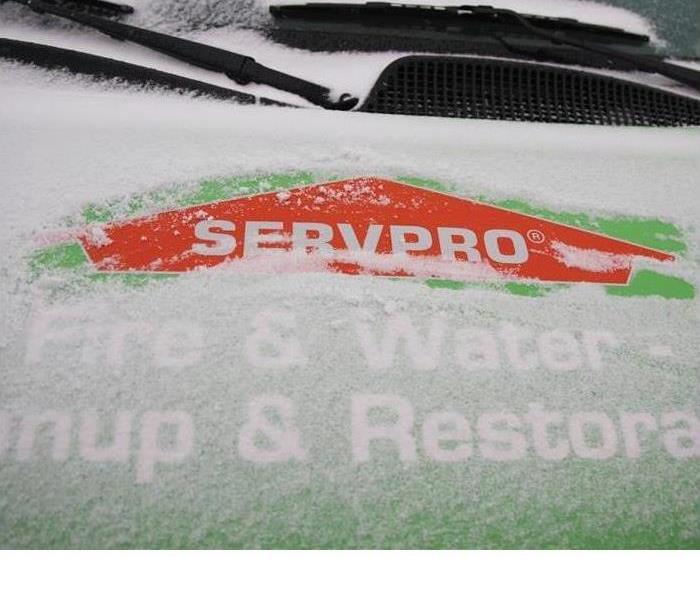 Call us today for all your winter weather needs! 573-756-5191
Call us today for all your winter weather needs! 573-756-5191
Winter weather will be here before we know it!
Prepare your home!
- Keep cabinet doors open during cold spells. This allows warm air to circulate around pipes.
- Keep a slow trickle of water flowing through faucets, especially if the pipes for faucets run through unheated or uninsulated areas of your home.
- Consider shutting off outdoor faucets. Find the shut-off valve in the basement or crawl space and turn it to “off .”
- If you follow the previous step, then open the outdoor faucet to help ensure it drains completely and the inner valve is shut off.
- Ensure gutters are clean and secure. Leaves and debris accumulate, causing a damming effect on gutters, which could lead to roof problems and water damage.
- Proper maintenance of your furnace can help reduce the risk of puffbacks.
Frozen Pipes
A frozen pipe can burst at the point where the ice blockage inside the pipe is located, but typically the rupture is caused by the backflow pressure between the water source and the blockage. A burst pipe can cause considerable damage to your property if not addressed quickly. SERVPRO of Farmington is faster to any size disaster, bringing the latest equipment and training to help make your water damage “Like it never even happened.”
Ice Dams
Ice dams can be a major problem during the winter season. They form when heated air melts roof snow downward into water dammed behind still-frozen ice. When the trapped water cannot safely flow or run into the gutter system, it can backflow under the roof’s shingles and into the structure’s interior areas. SERVPRO of Farmington can help mitigate water damage caused by ice dams and help you get your structure back to preloss condition.
Puffbacks
A puff back is a messy furnace malfunction that occurs when an oil burner backfires, sending soot throughout your home or business. It can happen all at once, covering an interior in grimy soot, or a puff back can leak soot particles more gradually. Equipped with the training, tools and experience to quickly and efficiently clean and restore your home or business, SERVPRO of Farmington will help make your puff back “Like it never even happened.”
When the storm rolls out, we roll in!
7/25/2017 (Permalink)
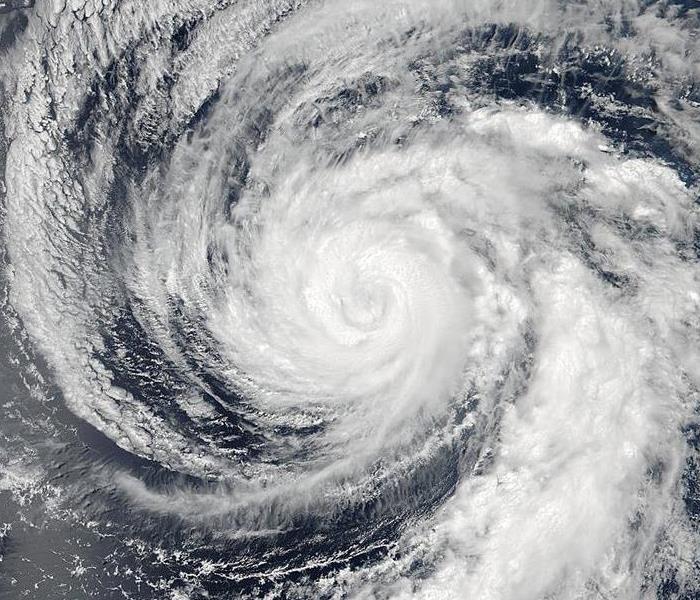 SERVPRO of Farmington is ready to help!
SERVPRO of Farmington is ready to help!
Although Missouri doesn't have hurricanes, SERVPRO of Farmington has assisted SERVPRO franchises on the East Coast to help with hurricane aftermath.
Storm Response
When the storm is a major event, you need more comprehensive restoration support. SERVPRO is “Ready for whatever happens.”
Time is Money
As the leader in water damage restoration, SERVPRO® knows fast mitigation is the key to limiting business interruption. With an unmatched national footprint of over 1,500 Franchises nationwide, SERVPRO® is faster to any size disaster and can be on-site within a few hours to help reduce the future damage water can cause. We have the right equipment, procedures and training to help ensure the structure is dry the first time, saving you time and money.
Storm Teams
SERVPRO has mobilization teams across the country to travel as needed to support large storm events. Need 1,000 crews for a month? Only SERVPRO can make it happen!
When the severe storm rolls out..we roll in!
4/5/2017 (Permalink)
Watch vs. Warning
A severe thunderstorm watch means that the potential exists for the development of thunderstorms which may produce large hail or damaging winds. A watch is issued by the SPC (Storm Prediction Center).
A severe thunderstorm warning means that a severe thunderstorm is occurring or is imminent based on Doppler radar information or a reliable spotter report. A warning is issued by the local National Weather Service office.
_______________________________________
Watch vs. Warning and Storm Basics are provided by NOAA (National Oceanic and Atmospheric Administration). For more information visit their website: www.noaa.gov
Storm Basics
A thunderstorm is a rain shower which you hear thunder. Since thunder comes from lightning, all thunderstorms have lightning.
A thunderstorm is classified as "severe" when it contains one or more of the following:
- Hail (One inch or greater)
- Winds in excess of 58 mph
- Structural wind damage
- Tornado
Tornado Facts
Tornadoes are arguably nature’s most violent storms. Generated from powerful thunderstorms, tornadoes generally appear as rotating, funnel-shaped clouds extending from the cloud base to the ground. With winds that can reach up to 300 miles per hour, tornadoes can cause massive destruction within seconds. Damage paths can be in excess of one mile wide and fifty miles long.
- The average tornado moves southwest to northeast, but tornadoes have been known to move in any direction.
- The average forward speed of a tornado is 30 miles per hour, but may vary from stationary to 70 miles per hour.
- Tornadoes can accompany tropical storms and hurricanes as they move onto land.
- Tornadoes are most frequently reported east of the Rocky Mountains during spring and summer months.
- Tornadoes are most likely to occur between 3 p.m. and 9 p.m.
Before the Storm
- To begin preparing, you should build an emergency supply kit and make a family communication plan.
- Remove dead or rotting trees and branches that could fall and cause injury or damage during a severe thunderstorm.
- Postpone outdoor activities. n Remember the 30/30 Lightning Safety Rule: Go indoors if, after seeing lightning, you cannot count to 30 before hearing thunder. Stay indoors for 30 minutes after hearing the last clap of thunder.
- Secure outdoor objects that could blow away or cause damage.
- Get inside a home, building, or hard top automobile (not a convertible). Although you may be injured if lightning strikes your car, you are much safer inside a vehicle than outside.
- Remember, rubber-soled shoes and rubber tires provide NO protection from lightning. However, the steel frame of a hard-topped vehicle provides increased protection if you are not touching metal.
- Shutter windows and secure outside doors. If shutters are not available, close window blinds, shades or curtains.
- Unplug any electronic equipment well before the storm arrives.
During the Storm
- Use your battery-operated NOAA Weather Radio for updates from local officials.
- Avoid contact with corded phones. Use a corded telephone only for emergencies. Cordless and cellular telephones are safe to use.
- Avoid contact with electrical equipment or cords. Unplug appliances and other electrical items such as computers and turn off air conditioners. Power surges from lightning can cause serious damage.
- Avoid contact with plumbing. Do not wash your hands, do not take a shower, do not wash dishes, and do not do laundry. Plumbing and bathroom fixtures can conduct electricity.
- Stay away from windows and doors, and stay off porches.
- Do not lie on concrete floors and do not lean against concrete walls.
- Avoid natural lightning rods such as a tall, isolated tree in an open area.
- Avoid hilltops, open fields, the beach or a boat on the water.
- Take shelter in a sturdy building. Avoid isolated sheds or other small structures in open areas.
- Avoid contact with anything metal—tractors, farm equipment, motorcycles, golf carts, golf clubs, and bicycles.
- If you are driving, try to safely exit the roadway and park. Stay in the vehicle and turn on the emergency flashers until the heavy rain ends. Avoid touching metal or other surfaces that conduct electricity in and outside the vehicle.
After the Storm
- Never drive through a flooded roadway.
- Stay away from storm-damaged areas to keep from putting yourself at risk from the effects of severe thunderstorms.
- Continue to listen to a NOAA Weather Radio or to local radio and television stations for updated information or instructions, as access to roads or some parts of the community may be blocked.
- Help people who may require special assistance, such as infants, children and the elderly or those with access or functional needs.
- Stay away from downed power lines and report them immediately. n Watch your animals closely. Keep them under your direct control.
- If you have storm damage to your home or property, call SERVPRO of Farmington. Timely mitigation is key to minimize secondary damages caused by severe storms.
SERVPRO of Farmington Services
Unexpected emergencies like severe weather call for immediate action. SERVPRO of Farmington knows immediate reaction to the disaster is important to helping you get your life back to normal.
Utilizing our 1-4-8 Service Response Guidelines*, SERVPRO of Farmington strives to:
- Contact you within 1 hour from notice of loss to arrange for service.
- Be on-site to begin mitigation services within 4 hours of notification.
- Provide verbal briefing of scope to you within 8 business hours of on-site arrival.
SERVPRO of Farmington can also perform pack-out services, which is removing salvageable personal property from the affected area for off-site cleaning and storage.
_______________________________________
*Exceptions may apply under certain conditions, such as a local catastrophic event or storm situation.



 24/7 Emergency Service
24/7 Emergency Service
















